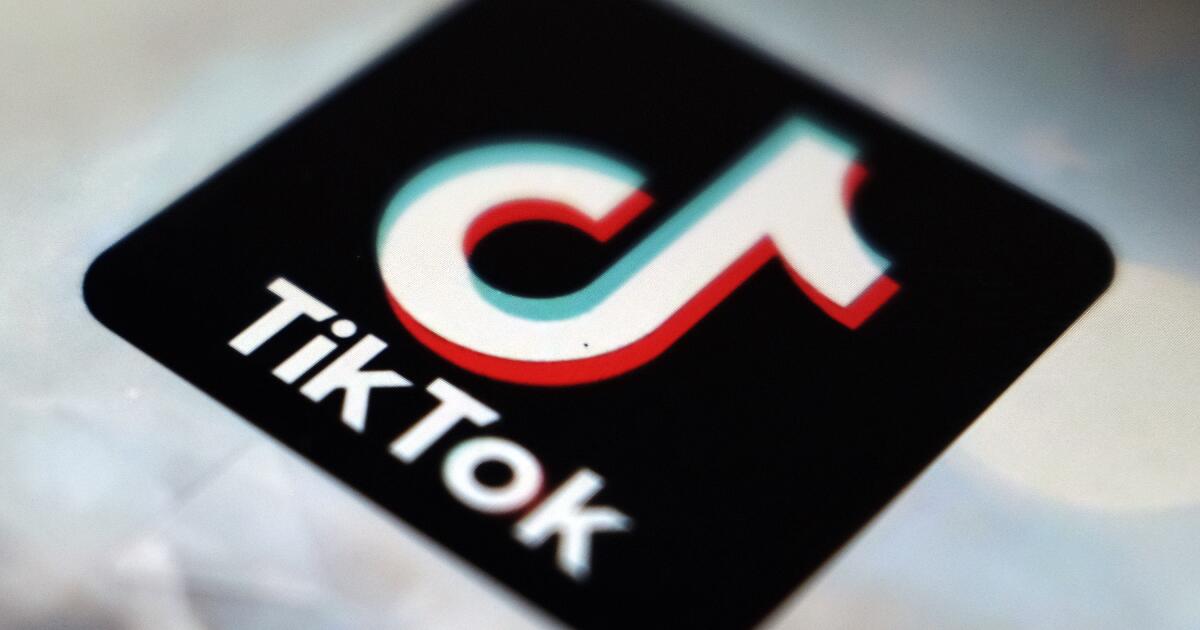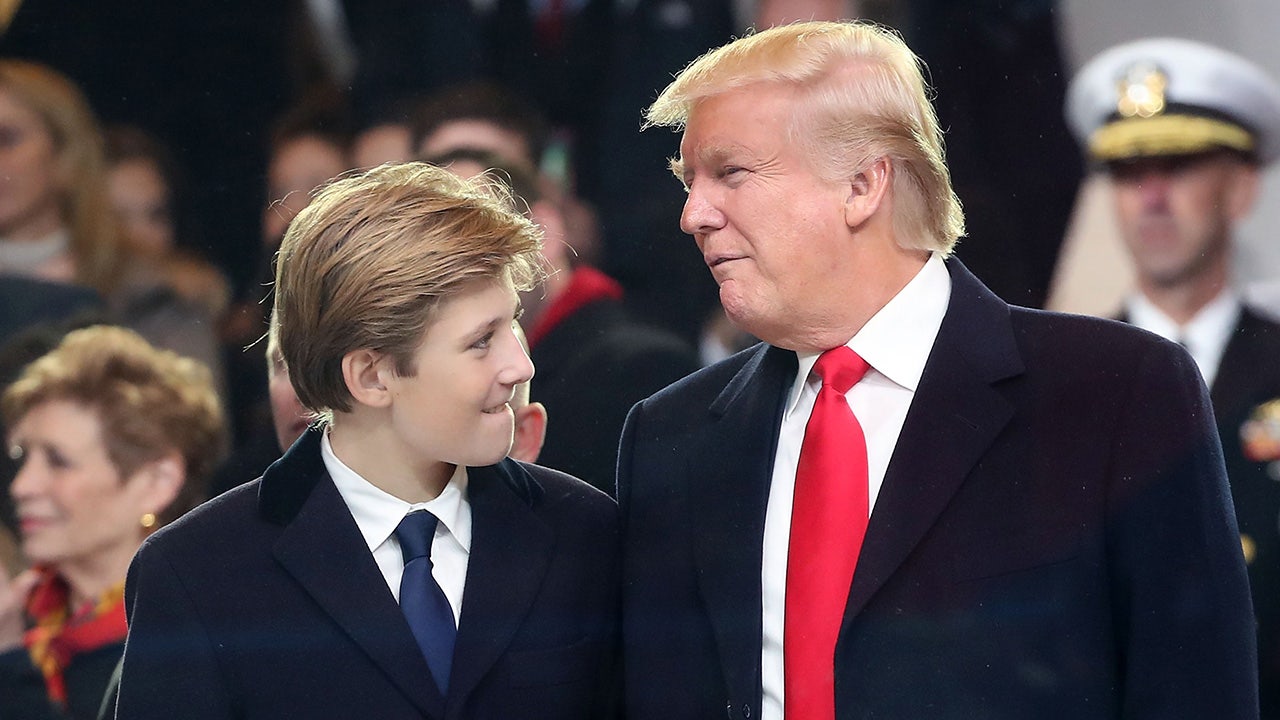World
The proposed EU fiscal rules fall short of the changes we need
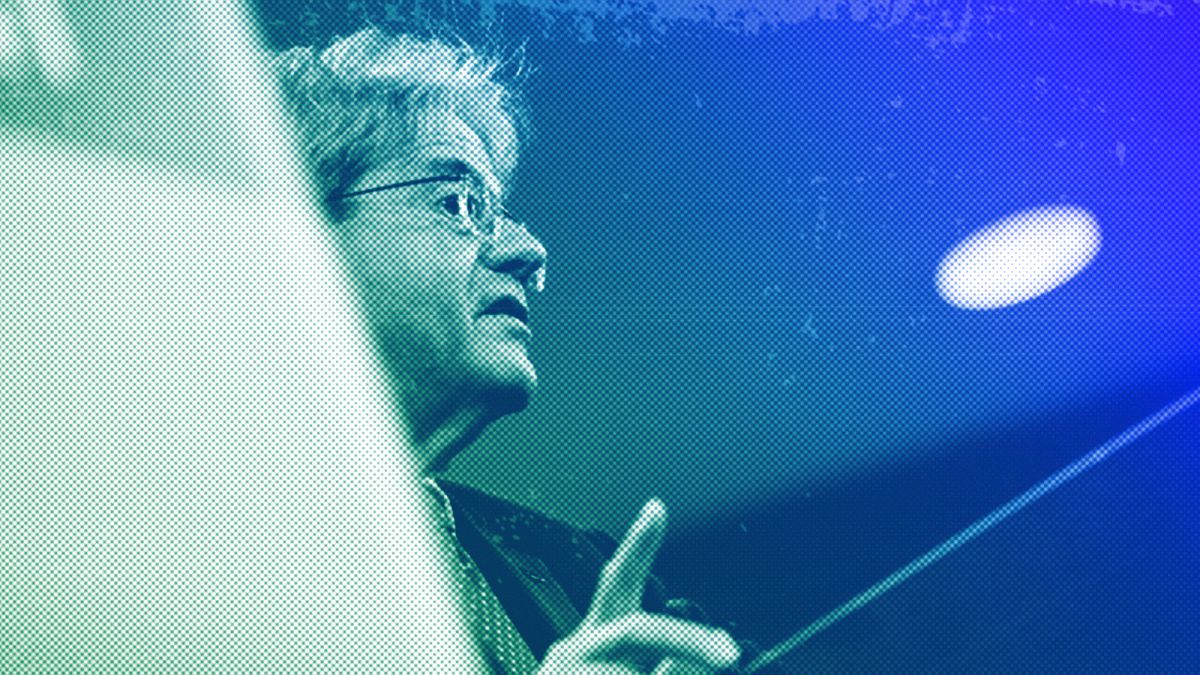
The opinions expressed in this article are those of the author and do not represent in any way the editorial position of Euronews.
The extraordinary nature of the pandemic led to unprecedented acts; today, similarly, the impending threat of the climate crisis on our planet, and its consequences on the very foundations of our society, require responses that rise to the occasion, Eleonora Volpe writes.
On 11 December, the European Economic and Social Committee met to discuss the proposal for new fiscal rules for the EU.
The next day, we met, together with Belgian and European trade unions, in a demonstration against the dangerous outcome of their proposal.
As More than Enough, a coalition of social organisations, unions, anti-poverty and environmental NGOs, we are profoundly worried about the unjustifiably restricting nature of the proposed text.
It is high time for European finance ministers to balance objectives of debt sustainability with the greatest form of instability that we face today: the climate and environmental crisis.
The journey towards climate neutrality requires a profound reconsideration of our economies and societies. We need significant investments by national governments in a transition that is truly green and truly socially just.
This should not be at odds with fiscal obligations of how much a country can spend for its citizens’ wellbeing; on the contrary, fiscal rules that are fit for purpose can be catalysts for objectives of climate and social justice.
The proposed fiscal rules fall short of the changes we need. A 20th-century-old obsession with debt reduction, at a moment when humanity faces unprecedented climate, environmental and social threats is irresponsible and dangerous, as it risks restricting the means with which national governments will be able to address the coming challenges.
There will be no debt sustainability without a serious commitment to a sustainable future.
We need responses that rise to the occasion
Let’s take a step back. Amidst the COVID-19 crisis, at a time when national governments had to respond promptly to the global health emergency, the fiscal rules were suspended temporarily until 2024.
The temporary suspension allowed greater flexibility to Member States to address the economic challenges ahead and avoid the constraining nature of the fiscal rules leading to an even more severe economic downturn.
Even before the onset of COVID-19, these rules had been the subject of much debate: their arbitrary nature constrained member states’ spending, often hindering national governments from effectively and promptly addressing economic crises and downturns and forcing cuts in social spending (without being effective in decreasing debt levels).
Today we are living in a parallel situation.
The extraordinary nature of the pandemic led to unprecedented acts; today, similarly, the impending threat of the climate crisis on our planet, and its consequences on the very foundations of our society, require responses that rise to the occasion.
The temporary suspension of the fiscal rules represented the perfect opportunity for their profound reconsideration and the chance for a paradigm shift from an economy that has measured its prosperity only in terms of a growth rate and its stability only in terms of a debt ratio.
The resulting environmental and social scarring is where we now start, fighting for an economy of social well-being and environmental prosperity, with no compromise between the two.
One-size-fits-all approach doesn’t work
The seriousness of the situation is well known in EU headquarters: according to the European Commission’s own estimates, the EU’s current underspending in its 2050 climate targets is staggering, ranging between €11,7 and €16,3 billion.
This adds to economic and social scarring coming from years of pursuing harsh austerity, such as cuts in social spending, that have hit the most vulnerable Europeans – youth, workers, women, and minorities, leaving them poorer and more vulnerable.
Failing to address this with the right tools and means will only contribute to making our economies more vulnerable to climate impacts and our societies more fragmented and polarised.
Yet, the text that is being discussed falls short of the transformative change we need.
By mostly focusing on yearly objectives for debt reduction, it neglects the need for proper fiscal space for public investments that are essential to foster a fair green transition and overlooks the highly beneficial effect that quality public investments (especially in climate) have on the overall economy (and as such repayment of debt).
By surrendering to the pressures of countries like Germany, the proposal lands on a one-size-fits-all agreement that will mostly affect those countries already grappling with the aftermath of austerity, the COVID-19 crisis and the energy crisis.
Overall, the proposal would unjustifiably restrict investments that are urgently needed for a just transition. By imposing a strict debt reduction, national governments would not be allowed enough fiscal leeway to invest in either the green or social dimension, and paradoxically putting the two priorities in competition.
The looming possibility of a bad deal
Unless these rules are improved significantly, they’re not going to help keep debts in check in the long term.
They’re going to stand in the way of most member states hitting their climate, jobs, and social targets.
What European citizens really need is a deal that shows we’ve learned from the past and gives governments the tools to actively invest in meeting the EU’s climate, social, and economic goals.
Rushing a deal now would leave us unprepared for the challenges of the next decade.
Finance ministers must consider the broader plea coming from civil society. More than Enough, together with many other civil society organisations in Belgium, is calling for fiscal rules that empower national governments to make the necessary structural investments for a prosperous and resilient future.
Let us not settle for a hurried agreement that locks us into insufficient fiscal capacity, impeding the realisation of climate, employment, and social targets. We cannot allow the return of austerity through the back door.
Eleonora Volpe is Finance Officer at the European Environmental Bureau (EEB).
At Euronews, we believe all views matter. Contact us at view@euronews.com to send pitches or submissions and be part of the conversation.

World
India Lok Sabha election 2024 Phase 4: Who votes and what’s at stake?

India is bracing itself for the fourth phase of its weeks-long elections on May 13 to elect 96 members of parliament to the Lok Sabha, or the lower house of parliament, as the world’s largest electoral exercise moves into its final month.
The two main contenders for power are Prime Minister Narendra Modi’s governing Bharatiya Janata Party (BJP) and the Indian National Developmental Inclusive Alliance (INDIA), a coalition of 26 parties led by the main opposition party, Rahul Gandhi‘s Indian National Congress.
Last week, the third phase of the voting saw Modi cast his vote in Gujarat’s Gandhinagar constituency. It also saw the competition between the two main contenders heighten as the Congress Party’s former President Sonia Gandhi said Modi and the BJP were focusing “only on gaining power at any cost”.
The fourth phase also features a bit of glamour in the east of the country, where Bollywood veteran Shatrughan Sinha is seeking re-election in West Bengal’s Asansol, and to the south, where actress Maadhavi Latha from the BJP is standing for the Hyderabad seat in Telangana. Latha is pitted against Asaduddin Owaisi, a four-time MP from the All India Majlis-e-Ittehadul Muslimeen party.
The first three phases of the election, which were held on April 19, April 26 and May 7, saw a voter turnout of 66.1, 66.7, and 61 percent, respectively. The voting so far has been lower than in the 2019 elections. In total, 969 million people are registered to vote in 543 parliamentary constituencies across 36 states and federally-governed union territories.
Who is voting in the fourth phase?
Registered voters across nine states and a union territory will cast their ballots for the following constituencies:
- Andhra Pradesh: All 25 constituencies in the southern coastal state
- Telangana: All 17 constituencies in the southern state
- Jharkhand: Four of the eastern state’s 14 constituencies
- Odisha: Four of the eastern state’s 21 constituencies
- Uttar Pradesh: Thirteen of the northern state’s 80 constituencies
- Madhya Pradesh: Eight of the central state’s 29 constituencies
- Bihar: Five of the eastern state’s 40 constituencies
- Maharashtra: Eleven of the western state’s 48 constituencies
- West Bengal: Eight of the eastern state’s 42 constituencies
- Jammu and Kashmir: One of the union territory’s five constituencies
Which are some of the key constituencies?
Hyderabad (Telangana): Asaduddin Owaisi is being challenged by the BJP’s Maadhavi Latha in his family bastion. Owaisi’s brother, Akbaruddin Owaisi is a member of the state legislative assembly while his father, Sultan Salahuddin Owaisi, represented the parliamentary constituency, with a substantial Muslim population, six times. Owaisi pitches himself as the voice of India’s Muslim minority whose issues he regularly raises in his parliamentary debates. Owaisi was given the “best parliamentarian” award in 2022.
Srinagar (Jammu and Kashmir): This constituency in Kashmir registered just 15 percent voting in the 2019 election, which was marred by a boycott. This is the first parliamentary election in Kashmir since the region’s special status was removed in August 2019. The two biggest mainstream pro-India parties in the region – the National Conference and People’s Democratic Party – have fielded Aga Syed and Waheed Parra, respectively, as their candidates.
Krishnanagar, Baharampur and Asansol (West Bengal): These three parliamentary contests in West Bengal state, bordering Bangladesh, offer a mix of star power and political significance. Bollywood actor-turned-politician Shatrughan Sinha is seeking re-election from Asansol, while ex-cricketer Yusuf Pathan is taking on senior Congress Party leader Adhir Ranjan Chowdhury, who has been representing Bahrampur since 1999. Chowdhury was also the leader of the opposition Congress Party in the outgoing Lok Sabha. Pathan is the candidate of the Trinamool Congress (TMC), the party that rules the state and is also aligned with the national opposition INDIA alliance – even though the coalition’s members are standing against each other in West Bengal.
Yet, the most high-profile electoral battle in the state on May 13, is in Krishnanagar, where the fiery TMC parliamentarian and fierce critic of Modi, Mahua Moitra, is seeking a second term. A former vice president of JPMorgan Chase based in London, Moitra entered politics in 2009. Her parliamentary speeches asking tough questions of the government often go viral. In December 2023, the firebrand MP was expelled from parliament after being accused of accepting cash to ask questions. She said her expulsion was a way to silence her. She has challenged her expulsion in the Supreme Court. The BJP has fielded Amrita Roy, whose husband is a descendant of the erstwhile king of the region, against Moitra.
Kannauj and Lakhimpur Kheri (Uttar Pradesh): Akhilesh Yadav, the leader of the Samajwadi Party – a regional powerhouse that has seen its influence shrink with the BJP’s rise – has decided to enter the electoral race in Kannauj in northern Uttar Pradesh state, which accounts for 80 seats in the parliament. The BJP currently governs the state. Kannauj, known for its perfume industry, has been a Yadav family bastion. Akhilesh, his father Mulayan Singh Yadav and his wife Dimple Yadav have represented the seat since 1999. But in 2019, Dimple lost to the BJP in a shock defeat. Akhilesh’s entry into the electoral fray is an attempt to wrest back the family pocket borough.
The other seat that has attracted a lot of attention is Lakhimpur Kheri, where controversial federal Minister of Home Affairs Ajay Mishra Teni is seeking re-election. Mishra has been caught in a storm since his son Ashish Mishra allegedly ran his car over farmers protesting against now-repealed farm laws. Ashish is out on bail and farmers’ groups as well as activists have been demanding that Mishra be denied a ticket by the BJP.
Indore (Madhya Pradesh): This constituency, a stronghold of the BJP, has been in the news for unlikely reasons. The Congress candidate Akshay Kanti Bam withdrew from the race at the last minute, after the last date for candidates to file nominations had passed. The Congress could not field a replacement and Bam later joined the BJP. Thirteen other candidates are in the fray, but the Congress Party has urged voters to opt for NOTA (none of the above) in protest.
When does the voting start and end?
Voting will begin at 7am local time (01:30 GMT) and end at 6pm (12:30 GMT). Voters already in the queue by the time polls close will get to vote, even if that means keeping polling stations open longer.
Complete election results for all phases are to be released on June 4.
Which parties rule the states being polled in the fourth phase?
- The BJP governs Madhya Pradesh and Uttar Pradesh outright.
- The BJP governs Maharashtra and Bihar in alliances.
- Odisha is governed by the Biju Janata Dal (BJD), which leans towards the NDA but is not a part of the alliance.
- Andhra Pradesh is governed by the Yuvajana Sramika Rythu (YSR) Congress Party.
- Congress governs Telangana.
- Jharkhand is governed by the INDIA alliance led by Jharkhand Mukti Morcha.
- West Bengal is governed by the All India Trinamool Congress Party, a member of the INDIA alliance.
- Jammu and Kashmir is governed directly by New Delhi. Its state legislature remains suspended.
Who won these Lok Sabha seats in 2019?
- In the last Lok Sabha elections, Congress, along with parties now affiliated with the INDIA alliance and those affiliated then with the Congress-led United Progressive Alliance, won 13 of the 96 seats to be decided on May 13.
- The BJP and parties affiliated with the NDA won 50 of the seats in 2019.
- The YSR Congress Party in Andhra Pradesh won 22 seats while the Telangana-based Bharat Rashtra Samithi (BRS) won nine seats in 2019.
- The All India Majlis-e-Ittehadul Muslimeen (AIMIM) won two seats in 2019.
How much of India has voted so far?
The first three phases of the Lok Sabha elections have already decided the fate of 284 MPs.
So far, voting has concluded for all seats in the states of Tamil Nadu, Kerala, Meghalaya, Assam, Manipur, Karnataka, Mizoram, Arunachal Pradesh, Nagaland, Uttarakhand, Chhattisgarh, Goa, Gujarat, Rajasthan, Sikkim, Tripura; the Andaman and Nicobar islands; and the Dadra and Nagar Haveli, Daman, Diu, Lakshadweep and Puducherry union territories.
The fifth phase will kick off on May 20 and the sixth on May 25, before the election heads towards the seventh and final phase on June 1.
World
Zendaya’s Stylist Law Roach Names Designers Who Refused to Dress Her on Red Carpets, Including Dior and Gucci: ‘If You Say No, It’ll Be Forever’

Stylist Law Roach revealed on “The Cutting Room Floor” podcast that Zendaya still hasn’t worn looks from five fashion houses after they refused to dress her early in her career.
“I would write the big five. I would write Saint Laurent, Chanel, Gucci, Valentino, Dior, and they would all say, ‘No, try again next year. She’s too green. She’s not on our calendar,’” Roach said during the interview.
“I still have the receipts,” he continued. “By the time she got to [the cover of] American Vogue [in 2017], she still had never worn any of those designers. She still hasn’t.”
Roach, who has styled the “Challengers” and “Dune” star since she was 14, clarified that Zendaya has worn designs by the “big five” in editorial shoots, but never in public or during red carpet appearances.
“She still has never worn Dior on a carpet. She still has never worn Chanel on a carpet. She has still never worn Gucci on a carpet — any press, any appearance, never. Never,” Roach said. “The first time she wore Valentino in public is when she had a contract.”
He continued, “When I said, ‘If you say no, it’ll be a no forever,’ that rang true for a long, long time.”
Despite announcing his retirement from celebrity styling over a year ago, Roach continues to work with Zendaya. He most recently styled Zendaya for this year’s Met Gala, where she served as one of the event’s co-chairs. After initially arriving in a custom Maison Margiela gown by John Galliano, Zendaya made a surprise second appearance on the Met Gala carpet in an archival Givenchy look — also by Galliano.
World
Biden's arms embargo on Israel 'emboldens' Hamas missile strikes against Jewish state
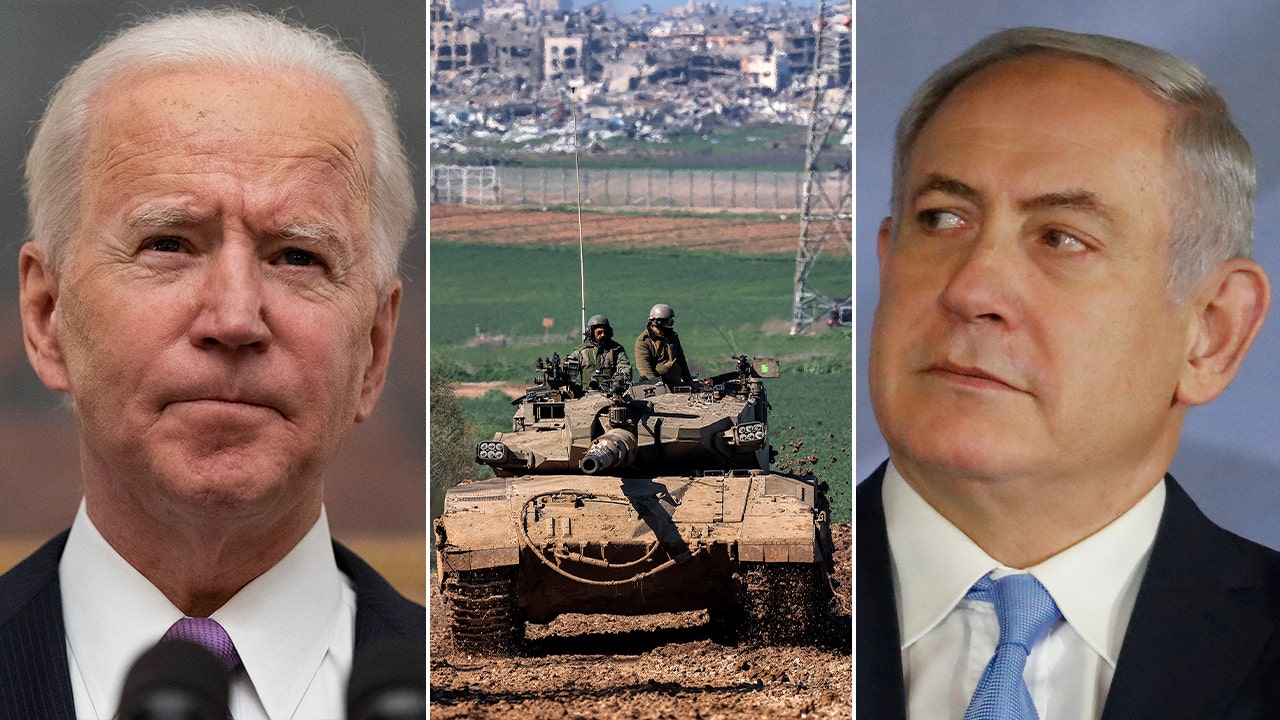
JERUSALEM—After President Biden gave his ultimatum of withholding offensive weapons to the Jewish state if Israel were to launch an invasion of Rafah, rocket attacks rained down on Israel on Friday from Rafah, with more rockets fired on Saturday.
Hamas launched rockets from Rafah at the southern Israeli city of Beersheva on Friday for the first time since December, as Iranian proxy Hezbollah sent a barrage of rockets into the northern Israel city of Kiryat Shmona, causing a massive fire. Within the Gaza Strip on Friday, four Israeli soldiers were killed.
“When administration officials attacked or berated Israel publicly previously during the war, Hamas hardened its demands in return for releasing hostages, in fact delaying and minimizing the chances of success of the delicate negotiation,” Jonathan Conricus told Fox News Digital. Conricus served in the Israel Defense Forces (IDF) for 24 years as a combat commander in Lebanon and the Gaza Strip.
UN, HUMAN RIGHTS, MEDIA GROUPS RELY ON HAMAS DEATH TOLL IN ‘SYSTEMATIC DECEPTION’: EXPERT
The aftermath of a Hezbollah rocket barrage in the northern Israeli city of Kiryat Shmona on May 10, 2024. Credit Erez Bar Simon/TPS-IL (Erez Bar Simon/TPS-IL)
“When Israel’s enemies detect tension between the U.S. and its most loyal and steadfast ally in the region, Israel, it emboldens them to attack Israel more and continue with their tactics of using human shields, since they understand that the U.S. will eventually punish Israel for defending itself, regardless of Hamas and Hezbollah’s actions.”
Conricus, who served as an IDF spokesman during the Gaza war and is now a senior fellow at the Foundation for Defense of Democracies added, “In the short term, these American statements will lead to enhanced violence and fighting, since they embolden Israel’s enemies. In the long term, they may push another American Middle Eastern ally away from the U.S. sphere of influence, and reinforce concerns harbored by many U.S. partners about the quality and steadfastness of U.S. support when needed the most.”
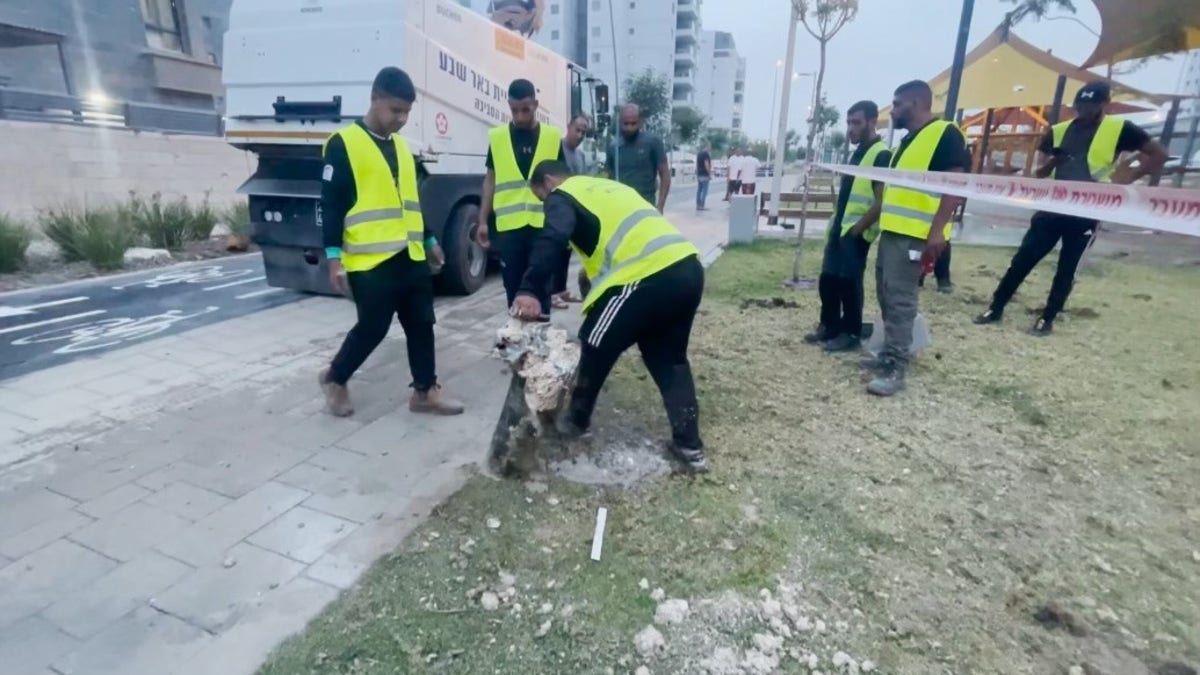
On Friday the IDF said that “five launches were identified crossing from central Gaza toward the area of Beersheva.” Nine additional launches were identified crossing from the area of Rafah toward the city and fell in open areas, the IDF stated. (Screenshot: IDF Spokesman’s Unit.) (IDF Spokesman’s Unit)
America’s former Ambassador to Israel during the Trump administration, David Friedman, posted a blunt message on X about the new Biden policy: “Hamas now firing rockets from Rafah into Beersheva — Israel’s largest southern city. Why wouldn’t they? — they have no fear of a reprisal. Biden has emboldened Hamas!”
Fox News Digital reported that many Israelis view Biden’s pause of weapons deliveries to be a betrayal of his assurance that he backs the Jewish state with an “ironclad” security promise.
Gen. Jack Keane (Ret.) told Fox & Friends on Friday that Biden is “walking away from Israel,” and called Biden’s decision “stunning.”
The enemies of Israel and America are closely watching Biden’s decision to reportedly create daylight between the U.S. and the Mideast’s only democracy, Israel.
WORLD HEALTH ORGANIZATION SILENT OVER HAMAS’ USE OF GAZA HOSPITAL AS TERROR HQ

IDF forces stand ready in southern Israel near the Gaza border for a possible ground offensive in Gaza’s southernmost city of Rafah to continue fighting Hamas and disbanding its battalions. Southern Israel, May 1, 2024. Photo by Noam Shaar/TPS (Photo by Noam Shaar/TPS)
On Thursday, John Kirby, the White House National Security Communications Adviser, said the U.S. was fully behind Israel. “The arguments that somehow we’re walking away from Israel fly in the face of the facts. I mean, this is a president who visited Israel within days of the October 7th attacks. This is a president who rushed additional military articles to Israel and, frankly, provided expertise from our own military to go over there to help them as they thought through their planning and their operation,” he told reporters at the White House.
Kirby continued “this is a president who put American pilots — fighter pilots — in the sky to help shoot down more than 300 missiles and drones fired by Iran in . . . mid-April. So the argument that somehow we’re walking away from Israel, we’re not willing to help them defeat Hamas just doesn’t . . . comport with the facts.”
Matthew Levitt, the director of the Reinhard Program on Counterterrorism and Intelligence at The Washington Institute, told Fox News Digital, “By default, working arms before hostages—including U.S. hostages—are released, and after Hamas’ bad faith behavior in negotiations, could embolden both Hamas and Hezbollah.”
Hamas has over 100 hostages in its captivity, including Americans. The terrorist mastermind behind Hamas’ massacre of nearly 1,200 people, including over 30 Americans, Yahya Sinwar is believed to be using hostages as human shields to hold off Israeli soldiers seeking to capture him in a tunnel deep below Gaza.

Palestinian Hamas terrorists are seen during a military show in the Bani Suheila district on July 20, 2017, in Gaza City, Gaza. A protester at Stanford University with a headband similar to the one worn by Hamas members was seen on an image submitted to the FBI. (Chris McGrath/Getty Images)
The State Department did not answer questions about whether Biden’s blockage of offensive weapons to Israel emboldens Hamas and Hezbollah.
On Thursday, spokesman Matthew Miller said, “What the President made clear is that we have concerns about a potential military operation in Rafah. I don’t think that’s any secret. We’ve been making those concerns known publicly, and we have made those concerns quite clear to the Government of Israel. And as the President noted, there are certain types of military assistance that we will not make available to Israel for use in a campaign in Rafah,” said Miller.
The Jewish Institute for National Security of America (JINSA) published a letter from a who’s who of retired U.S. military leaders, criticizing Biden’s arms directive. “Amid surging antisemitism in America and the world, following the largest one-day loss of innocent Jewish life since the Holocaust, U.S. support for the only Jewish state should be clear, unwavering, and not conditioned. The benefits of this partnership for the American people and this important region are many, and too valuable to forsake.”
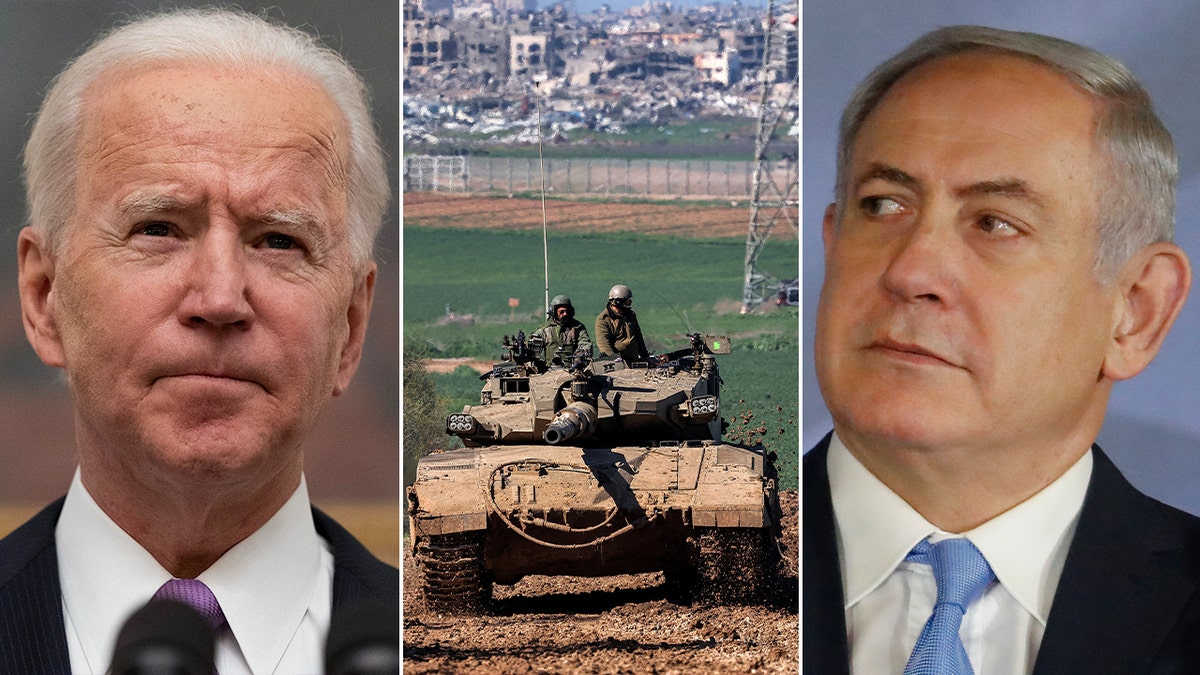
President Biden in between a photo of an IDF tank and Israeli PM Benjamin Netanyahu (AP, Getty Images)
The letter added: “America must support Israel as it restores its security, shattered on October 7, against Iran and its terrorist proxies in Gaza, Lebanon, Syria, Iraq, and Yemen that all seek to destroy the Jewish state. These forces are also enemies of the United States and everything we stand for.
“This Iranian-backed axis of terror, as well as other adversaries and allies around the world, are watching closely to see whether the United States will stand by one of its closest allies fighting in self-defense, even when the going gets tough.”
Richard Goldberg, a senior adviser at the Foundation for Defense of Democracies and former National Security Council official, warned, “There’s zero doubt that Iran and Hezbollah are going to escalate the longer this illegitimate embargo drags on. Our shared enemies feed on the perception of space between the United States and Israel, and the projection of weakness and desperation in both capitals.”
Fox News Digital press queries to the White House and Israel’s Ministry of Foreign Affairs and Prime Minister’s Office were not immediately returned.
-

 News1 week ago
News1 week agoPolice enter UCLA anti-war encampment; Arizona repeals Civil War-era abortion ban
-

 News1 week ago
News1 week agoSome Florida boaters seen on video dumping trash into ocean have been identified, officials say
-

 Politics1 week ago
Politics1 week agoThe White House has a new curator. Donna Hayashi Smith is the first Asian American to hold the post
-

 Education1 week ago
Education1 week agoVideo: President Biden Addresses Campus Protests
-
)
) Movie Reviews1 week ago
Movie Reviews1 week agoThe Idea of You Movie Review: Anne Hathaway’s honest performance makes the film stand out in a not so formulaic rom-com
-

 World1 week ago
World1 week agoUN, EU, US urge Georgia to halt ‘foreign agents’ bill as protests grow
-

 World1 week ago
World1 week agoIn the upcoming European elections, peace and security matter the most
-

 World1 week ago
World1 week agoArizona Senate repeals near-total 1864 abortion ban in divisive vote








